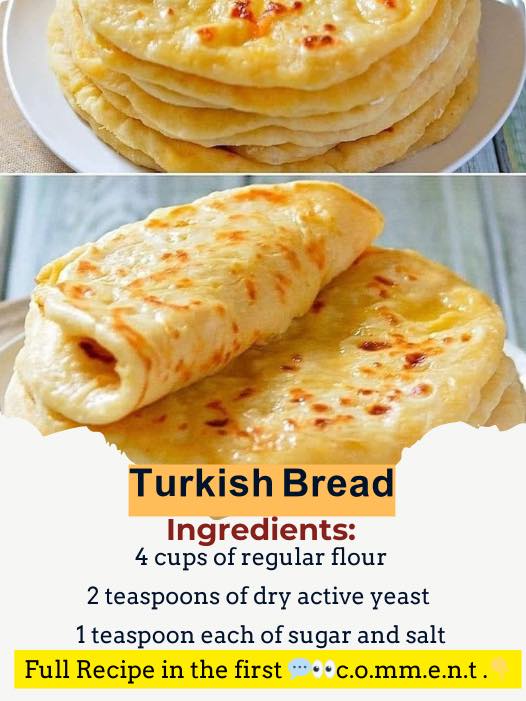Discover the joy of crafting the simplest yet most delectable bread – Turkish bread, a culinary marvel that requires minimal effort for maximum flavor. This recipe boasts a no-knead method, making it an ideal choice for both novice and seasoned bakers. Delight in the process as you combine basic ingredients and shape the dough, resulting in a bread that is irresistibly light and fluffy. Let’s dive into the delightful journey of creating this Turkish bread masterpiece!
Ingredients:
- 500 g (1 pound) all-purpose flour
- 150 ml (5 fl. oz) warm milk
- 150 ml (5 fl. oz) warm water
- 1 tsp salt
- 2 tbsp dry yeast
- 3 tbsp olive oil
- Chopped parsley
- Chili flakes
Step-by-Step Guide to Crafting Turkish Bread
1. Whisking Magic
Begin by whisking together the dry yeast and salt with the flour, creating a harmonious blend of flavors. Introduce the warm milk and water into the mix, and knead the ingredients just enough to absorb the liquids. This initial mixing should form a shaggy dough, which means it will be slightly sticky and not fully cohesive yet, but don’t worry – this is the first step towards creating a beautiful dough.
2. Olive Oil Elegance
Infuse the dough with richness by incorporating the olive oil. Pour the olive oil into the dough and start kneading. Knead this delightful mixture until it transforms into a smooth, cohesive dough, approximately 10 minutes of culinary meditation. The kneading process is essential for developing the gluten, which gives the bread its structure and chewiness. You’ll notice the dough becoming more elastic and less sticky as you knead.
3. Rising Symphony
Shape the dough into a ball, coat it with vegetable oil, and place it in a large bowl. Cover the bowl with a damp cloth or plastic wrap and allow it to bask in a warm haven for an hour, patiently waiting for it to double in size. This phase sets the stage for the bread’s light and airy texture. If your kitchen is cool, you can place the dough in an oven with just the light on to create a warm environment.
4. Divine Divisions
Once the dough has risen to perfection, gently punch it down to release any built-up air. Divide it into six equal portions and skillfully roll each into a charming ball. Let these balls rest for about 10 minutes to relax the gluten, making them easier to roll out.
5. Pan Perfection
On a pan heated to medium-high, roll out each ball into a flatbread. Cook for 5–6 minutes, generously flipping every 2.5-3 minutes until the bread forms a delightful pocket in the middle. This pocket is the hallmark of well-made Turkish bread and is perfect for stuffing with your favorite fillings.
6. Finishing Flourish
Elevate your Turkish bread’s allure by brushing each hot flatbread with oil and sprinkling a vibrant mix of chopped parsley and chili flakes on top. This final touch adds a burst of freshness and a hint of warmth. For an extra layer of flavor, you can also sprinkle a bit of sea salt or za’atar.
Tips for Perfect Turkish Bread:
- Consistency of Dough: The dough should be soft but not too sticky. If it’s too sticky, add a little more flour; if it’s too dry, add a bit more water.
- Resting the Dough: Allowing the dough to rest before rolling it out helps in achieving a better texture and easier handling.
- Cooking Temperature: Make sure your pan is adequately heated before placing the dough on it. This ensures that the bread puffs up correctly and cooks evenly.
- Storage: Turkish bread is best enjoyed fresh, but you can store any leftovers in an airtight container for up to two days. To reheat, sprinkle a bit of water on the bread and warm it in the oven.
Embark on this delightful culinary adventure, and relish the pride of creating Turkish bread that transcends simplicity, making every bite a moment of pure bliss. The process is as rewarding as the outcome, allowing you to connect with a tradition that has been cherished for generations. Whether enjoyed on its own, paired with dips, or stuffed with your favorite ingredients, this Turkish bread will become a staple in your culinary repertoire. Enjoy the journey and the delightful flavors that come with it!
Colclusion :
As we conclude our journey through the creation of Turkish bread, we find ourselves not just with a recipe, but with a newfound appreciation for the artistry and simplicity of bread-making. In the kitchen, we embarked on a delightful adventure, combining basic ingredients with care and patience to craft a culinary masterpiece that transcends its humble origins.
Turkish bread, with its light and airy texture, its subtle infusion of olive oil, and its final flourish of herbs and spices, is more than just sustenance; it is a testament to the joy of creation and the satisfaction of sharing a meal with loved ones. From the moment the dough comes together to the final sizzle of the flatbread on the pan, each step is an opportunity to connect with tradition and to savor the process of transformation.
As we bite into a warm slice of Turkish bread, we taste not just flour and water, but centuries of culinary tradition and the pride of craftsmanship passed down through generations. Whether enjoyed with a simple smear of butter or as a vessel for flavorful fillings, each bite is a celebration of flavor, texture, and the joy of sharing a meal with those we hold dear.
So let us savor each moment in the kitchen, each aroma that fills the air, and each slice of bread shared with friends and family. For in the creation of Turkish bread, we find not just nourishment for the body, but nourishment for the soul—a reminder of the simple pleasures that bring us together and the enduring legacy of food as a source of comfort, joy, and connection.
Source of the picture : foodit










